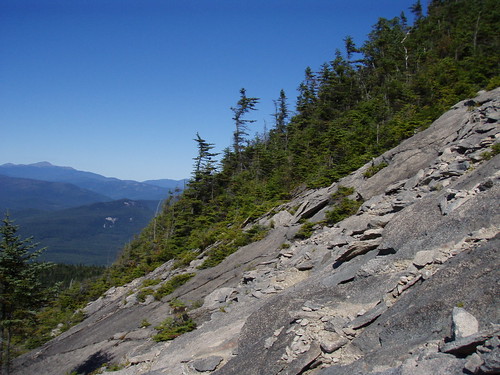This past Monday I hiked Mt. Jackson, checking off another 4k footer from the list of 48 in NH. The trailhead was located off RT302, right next to Crawford Notch in the heart of the White Mountain National Forest. At the base, the temperature was around 40 degrees Fahrenheit, so I expected much colder temps at the summit and prepared accordingly.
It was a steady climb up; there were only a few places where I didn't feel like I was climbing stairs. Since I was constantly moving, my body warmed up and I ended up storing most of the warm clothing in my bag during the hike. Most of the landscape was lush -- even tropical (it's hard to imagine for New England, but there are rain forests here!).
Somewhere around 3,500', I looked up and the tops of the trees were covered in something white. I realized it was ice! At the same time, I noticed the wind was blowing incredibly strong just 15' above me; the clouds, so close I felt like I could reach out and touch them, were whipping by as if on a racetrack. From that point onward, things just got colder.
When I reached the summit, everything was frozen. It was incredible. The wind was gusting so strongly that I struggled to maintain my balance. I took off one of my gloves to take pictures and within thirty seconds I couldn't feel my fingers! There were 360-degree views of the surrounding Presidentials -- absolutely stunning.
I decided to take the Mt. Webster loop back instead of going the same way I came. It was an extra 1.6 miles, but I was in no rush. But before I left the summit, I heard a bird whistling to me. I looked over and there he was, perched ten feet in front of me on a frozen pine branch. Realizing I was on part of the Appalachian Trail, I suspected he might be accustom to being fed by passing hikers. I opened a food bar and sure enough, he ate right out of my hand!
The hike from the summit of Mt. Jackson to the summit of Mt. Webster was mostly easy-going terrain. There were lots of slippery log walkways winding through swampy areas that were overgrown with green moss. It was also still cold (the trees were still under 15', and I was still exposed to the strong winds).
Overall, it was an incredible hike. The four and a half hours felt more like eight and the changing landscape, high winds, and friendly wildlife made the trip exhilarating. I didn't pass a single person on the entire hike, probably due to the fact that it was Monday. 🙂
Date of Hike
2009/11/16
Hiking Time
Total Time (including breaks): 4 hours
Book Time: 4-5 hours
Hiking Distance
Round Trip: 5.73 miles
Total Climb
2,232′













